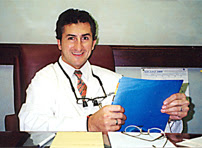Dentist Drills Holes in PTO's 2(d) Refusal of "SMILEWATER" for Dental Mineral Water
Dean C. Vafiadis, D.D.S., was surely smiling when the Board reversed a Section 2(d) refusal to register his mark SMILEWATER for "mineral water distributed in the dental field." The Board found the mark not confusingly similar to the registered mark SMILE & Design (shown below) for "soda water." In re Vafiadis, Serial No. 78509712 (January 24, 2006) [not precedential].

The PTO relied on third-party registration evidence in arguing that the Doctor's mineral water is related to soda water. The Board, however, found those registrations of "little probative value," because the subject application is limited to mineral water distributed in the dental field.
"'Distributed in the dental field' implies not only a restriction in trade channels but also a restriction as to the purpose and function of the goods, at a minimum, to the extent that they are sold in the dental field. None of the third-party registrations includes 'mineral water distributed in the dental field.'"
As to channels of trade, "'the dental field' cannot be considered to be part of the 'normal' channels of trade for soda water." The normal channels for soda water would include grocery stores and convenience stores, "but not a dentist's office." Moreover, even if Applicant's goods were to be sold next to other dental products in the supermarket, that would not suffice to establish that the goods are related to soda water. See Federated Foods, Inc. v. Fort Howard Paper Co., 192 USPQ 24, 29 (CCPA 1976) [the fact that two products are sold in the same large store does not mean they are related for Section 2(d) purposes.]

Turning to the marks, the Examining Attorney maintained that SMILE is the dominant portion of both marks, whereas the Doctor asserted that his mark is a "clever new word combination" and that the registered mark's smiley face design readily distinguished the marks. The Board sided with the Doctor, ruling that the first du Pont did not weigh in favor of a finding of likely confusion.
"In view of the visually prominent design element in registrant's mark and the difference in connotation and overall commercial impression of the literal portions of the marks in the context of applicant's goods, we find that, despite both marks including the word SMILE, the differences are sufficient to distinguish applicant's mark from registrant's mark."
The Board therefore extracted the refusal to register from the PTO's jaw.
Text Copyright John L. Welch 2007.




0 Comments:
Post a Comment
<< Home